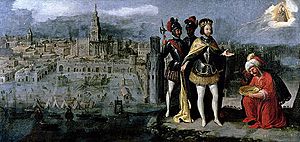Siege of Seville facts for kids
Quick facts for kids Siege of Seville |
|||||||
|---|---|---|---|---|---|---|---|
| Part of the Reconquista | |||||||
 The Torre del Oro (at right) anchored one end of the barricade in the Guadalquivir. It marks where the Moorish defenses spanned the river. |
|||||||
|
|||||||
| Belligerents | |||||||
| Almohad Caliphate | |||||||
| Commanders and leaders | |||||||
| Axataf | |||||||
| Strength | |||||||
| Unknown | Unknown | ||||||
| Casualties and losses | |||||||
| Unknown | Unknown | ||||||
The Siege of Seville was a long military attack on the city of Seville in Spain. It lasted for 16 months, from July 1247 to November 1248. The attack was led by Ferdinand III of Castile, who was the king of Castile. His forces successfully captured Seville.
This event was a big part of the Reconquista. The Reconquista was a long period when Christian kingdoms in the Iberian Peninsula (modern-day Spain and Portugal) fought to take back land from Muslim rulers.
Contents
What Was the Siege of Seville?
The Siege of Seville was a major military event. It was one of the most difficult operations King Ferdinand III undertook. It also showed the growing power of Castile's navy. Ramón de Bonifaz led the ships and is seen as Castile's first admiral.
Why Was Seville Important?
After the city of Jaén was captured in 1246, Seville and Granada were the last big cities in the Iberian Peninsula still under Muslim rule. Granada would remain independent for much longer, until 1492. Capturing Seville was very important for the Christian kingdoms. It helped them gain more control over the region.
How the Siege Happened
In the summer of 1247, the Castilian army began to surround Seville. They cut off the city from the north and east. This prepared the way for the main attack.
The siege officially started when Ramón de Bonifaz sailed his ships up the Guadalquivir River. He had 13 large ships called galleys and some smaller boats. He easily defeated about 40 smaller enemy ships.
On May 3rd, the Castilian fleet broke a special bridge. This was a pontoon bridge that connected Seville to a nearby area called Triana. Breaking this bridge was a big step. It made it harder for people and supplies to get in or out of Seville.
What Happened at the End?
Some historical writings say that the Muslim defenders used early forms of artillery during the siege. These machines might have fired rocks. However, it is not fully clear if these were like modern cannons.
The city of Seville eventually ran out of food. Because of this severe hunger, the city had to give up. This happened on November 23, 1248.
The agreement said that King Ferdinand's troops could enter the Alcázar (a royal palace) within a month. King Ferdinand made his grand entry into Seville on December 22, 1248.
Some old Muslim records say that about 300,000 people left the city after it was captured. However, many historians think this number is much too high.
See also
 In Spanish: Reconquista de Sevilla para niños
In Spanish: Reconquista de Sevilla para niños

